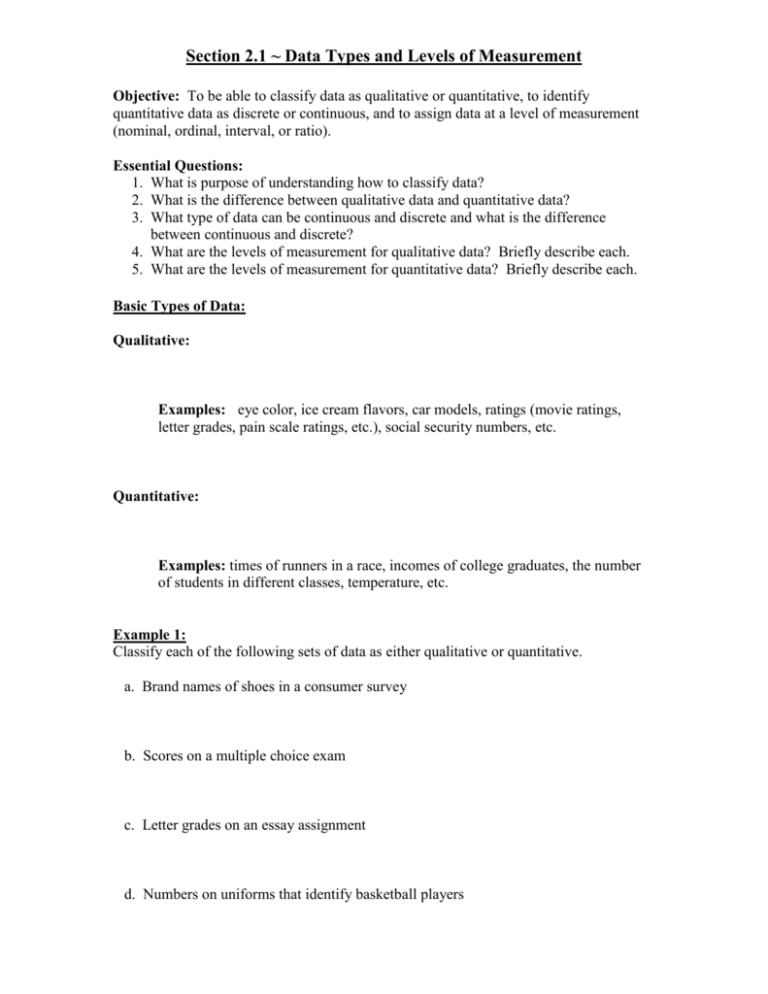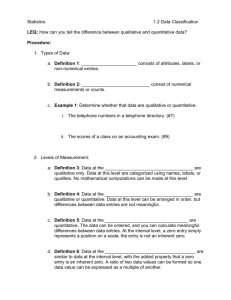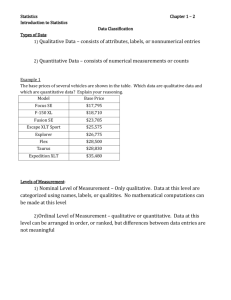Section 2
advertisement

Section 2.1 ~ Data Types and Levels of Measurement Objective: To be able to classify data as qualitative or quantitative, to identify quantitative data as discrete or continuous, and to assign data at a level of measurement (nominal, ordinal, interval, or ratio). Essential Questions: 1. What is purpose of understanding how to classify data? 2. What is the difference between qualitative data and quantitative data? 3. What type of data can be continuous and discrete and what is the difference between continuous and discrete? 4. What are the levels of measurement for qualitative data? Briefly describe each. 5. What are the levels of measurement for quantitative data? Briefly describe each. Basic Types of Data: Qualitative: Examples: eye color, ice cream flavors, car models, ratings (movie ratings, letter grades, pain scale ratings, etc.), social security numbers, etc. Quantitative: Examples: times of runners in a race, incomes of college graduates, the number of students in different classes, temperature, etc. Example 1: Classify each of the following sets of data as either qualitative or quantitative. a. Brand names of shoes in a consumer survey b. Scores on a multiple choice exam c. Letter grades on an essay assignment d. Numbers on uniforms that identify basketball players Quantitative Data: Quantitative data can be either continuous or discrete. Continuous data: Examples: Weight; Time; Distance; Money; Discrete data: Examples: Number of students in a class; Shoe sizes; Number of times a student took their driver’s test; Example 2: For each data set, indicate whether the data are discrete or continuous. a. Measurements of the time it takes to walk a mile b. The numbers of calendar years (such as 2007, 2008, 2009, etc.) c. The numbers of dairy cows on different farms d. The amounts of milk produced by dairy cows on a farm Levels of Measurement: A level of measurement is a further classification of qualitative and quantitative data. Qualitative (categorical) levels of measurement: Nominal: Examples: eye color, ice cream flavors, jersey numbers, and gender of animals Ordinal Examples: star ratings of movies, pain level ratings, letter grades on a test, etc. Quantitative levels of measurement: Interval: Example: Temperature o Intervals (differences) are meaningful - 81˚F is hotter than 80˚F by the same amount that 28˚F is hotter than 27˚F o Ratios (comparing the two numbers by division) are not meaningful - 20˚F is not twice as hot as 10˚F because it’s zero point (0˚F) does not represent a state of “no heat” Ratio: Example: Walking distance; o Intervals (differences are meaningful) - 10 miles is further than 5 miles by the same amount that 20 miles is further than 15 o Ratios (comparing the two numbers by division) are meaningful - 10 miles really is twice as far as 5 miles because there is a true zero when it comes to distance Example 3: Identify the level of measurement for each of the following sets of data. a. Numbers on uniforms that identify players on a basketball team b. Student rankings of cafeteria food as excellent, good, fair, or poor c. Calendar years of historical events, such as 1776, 1945, or 2001 d. Temperatures on the Celsius scale e. Runners’ times in the Boston Marathon Summary: o o o







